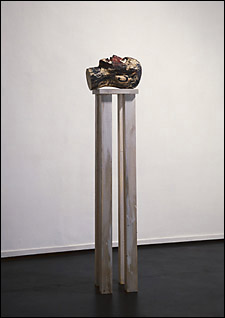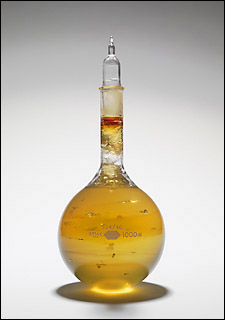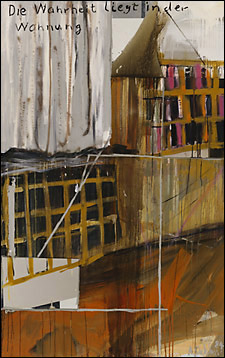Collecting with an eye toward future facilities
Harvard University Art Museums showcase contemporary works in three fall exhibitions
This fall, the Harvard University Art Museums (HUAM) present three special exhibitions that highlight their increased commitment to the field of contemporary art. Each of the museums – the Fogg Art Museum, the Busch-Reisinger Museum, and the Arthur M. Sackler Museum – currently has an exhibition of contemporary works on view. Together, these exhibitions represent a diverse range of media, objects, and geographical classifications. The exhibitions reflect the Art Museums’ initiative to increase their capacity to show and collect contemporary art by expanding holdings of these works, while planning for future facilities in Allston Brighton, where gallery space will be designed primarily for modern and contemporary art exhibitions.
“Nominally Figured: Recent Acquisitions in Contemporary Art,” on display at the Fogg through Feb. 25, 2007, represents the most recent acquisitions of contemporary works by HUAM. The installation reflects an emphasis on work using the body, body parts, schematic notation, or figures of speech and text. While the dialogue between figuration and abstraction dominated much of the discourse around mid-20th century art, this exhibition features works with an expanded notion of the figure as an artificial construction that is evident in most art today.
The installation includes drawings, sculpture, paintings, photographs, and video by such artists as Louise Bourgeois, Carl Andre, Liz Larner, Richard Artschwager, Frank Egloff, Paul Feeley, John Wesley, Mel Bochner, Paul McCarthy, Dennis Oppenheim, David Hammons, Steve McQueen, and Bruce Nauman. The exhibition was organized by Linda Norden, former associate curator of contemporary art, and will be installed in two rotations. The first rotation runs through Oct. 15, and the second will run Oct. 21 through Feb. 25.
“German Art of the 1980s from the Heliod Spiekermann Collection” is on view at the Busch-Reisinger through Dec. 3. More than 25 years ago, Heliod Spiekermann began collecting art by her contemporaries, becoming a deeply involved, passionate, and acute observer – especially of the rise of Cologne as an art center in the 1980s. Getting to know artists through extensive studio visits and as patients in her dentist’s chair, she has gathered a distinguished personal collection that provides an ideal starting point for looking back at the art of a decade currently undergoing renewed scrutiny and re- evaluation. This exhibition of generous loans presents five major paintings and sculptures by Georg Baselitz, Georg Herold, Albert Oehlen, and Rosemarie Trockel. The focus is strongly on the individual works, although these artists also stand for important tendencies of the 1980s: Baselitz for the revival of expressive, gestural art making marked by the persona of the artist; Oehlen and Herold for a spirit of neo-Dadaist skepticism about art, style, and ideology; and Trockel for the emergence of a rigorously intelligent art prompted by feminist concerns. The exhibition was organized by Peter Nisbet, Daimler-Benz Curator of the Busch-Reisinger Museum.


“The New Chinese Landscape: Recent Acquisitions,” an exhibition showcasing the Harvard University Art Museums’ most important contemporary Chinese acquisitions to date, is on display through Nov. 12 at the Sackler. This tightly focused exhibition of six paintings and one sculpture represents an often overlooked category of works that push the boundaries of what the term “contemporary” means in non-Western contexts. Identified as contemporary Chinese ink paintings, these works are characteristic of both classical ink landscapes and contemporary art. In some instances, it is an entirely new approach to the Chinese landscape. In others, it is a newly invented type of brushwork or a reliance on classical Chinese models different from those sanctioned by earlier generations of traditional artists. The artists’ use of new techniques, styles, and both Western and Chinese sources of inspiration, while working within the framework of traditional materials, formats, and subjects, clearly sets their works apart from traditional Chinese ink paintings and distinguishes them as contemporary. The exhibition was organized by Robert D. Mowry, Alan J. Dworsky Curator of Chinese Art.
As announced this past February, the Harvard University Art Museums have unveiled a comprehensive master plan to transform their facilities for teaching, research, and presentation of its renowned collections. A core goal of the plan is to improve the ability of the art museums to exhibit contemporary works of art. To achieve that goal, the plan calls for the renovation of the historic 32 Quincy St. site in Cambridge, the current home of the Fogg and Busch-Reisinger Museums, and the development of new facilities in Allston Brighton.
The planned Harvard University Art Museums Allston Brighton Center will house public galleries primarily for the exhibition of the art museums’ growing collection of modern and contemporary art, the scale and nature of which frequently require larger and/or more flexible exhibition spaces than are available in their current facilities. The Allston Brighton Center will also include spaces for public programs, a study center, teaching and research facilities, conservation laboratories, collections, and offices for staff. During the renovation of the Quincy Street site, the art museums will maintain a campus presence in Cambridge with highlights from the three museums on display at the Sackler Museum, located on Broadway adjacent to Quincy Street.

“We envision a future when the Harvard University Art Museums can exhibit contemporary works of art in facilities that are specifically designed for that purpose. A large part of our current planning has developed with that objective in mind,” said Thomas W. Lentz, Elizabeth and John Moors Cabot Director of the Harvard University Art Museums. “As we look forward to new facilities in Allston Brighton, we are building our collection of modern and contemporary art and enhancing our programming in that area. These three exhibitions are an indication of our commitment to offering our students and visitors the chance to study and interact with a wider range of visual art.”
Alan J. Dworsky Curator of Chinese Art Robert D. Mowry will kick off the M. Victor Leventritt Symposium – ‘The New Chinese Landscape: Recent Acquisitions’ – with a keynote address Oct. 13 at 6 p.m. in the Sackler Museum lecture hall. Mowry will speak on ‘Contemporary Chinese Ink Painting: The Sackler Enters a New Arena of Collecting.’ The daylong symposium will commence at 9 a.m. Oct. 14 with Chinese painters Li Huayi, Li Junyi, Liu Dan, and Liu Guosong discussing ‘The New Chinese Landscape.’ This symposium will bring together the four artists represented in the exhibition to discuss their art backgrounds, inspirations, and techniques, and to participate in a dialogue that addresses what ‘contemporary art’ means within a Chinese context. The symposium is free and open to the public. A reception will follow the Oct. 13 talk.
The M. Victor Leventritt Forum on German art of the 1980s will take place Oct. 28 from 10 a.m. to 1 p.m. in the Fogg Art Museum, Christian Room. Free to the public, ‘Made in Western Germany: Revisiting German Art of the ’80s’ is a mixed-format forum organized to complement the Busch-Reisinger’s exhibition ‘German Art of the 1980s from the Heliod Spiekermann Collection.’ The forum will offer five to six 30-minute presentations covering such topics as the role of women and feminist art, problems surrounding the display of locally specific art in an American context, the activities of the collectors, and the importance of music in the creative ferment of this fascinating decade.




